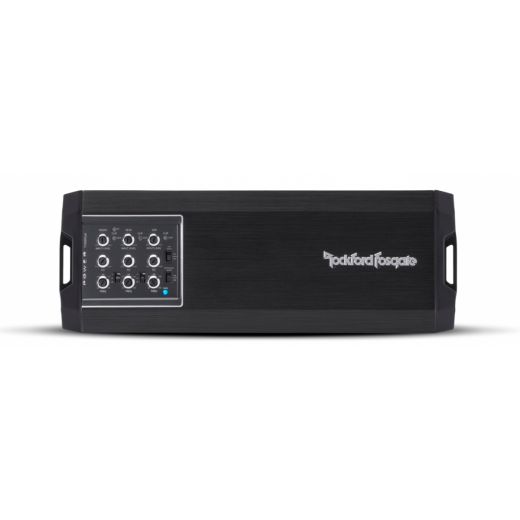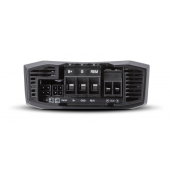Amplifier Rockford Fosgate POWER T1000x5 ad
More about the product
- Use our consulting room
- You can return the goods to us within 14 days
- Try the product at our store
Amplifier Rockford Fosgate POWER T1000x5 ad
The Power T1000X5ad is a 1000 RMS watt multi-channel amplifier that is built on the foundations of Class AD amplifiers with one goal - to produce flawless audio with perfect efficiency. Constant power technology makes this machine a breeze to increase rated power by up to 25% per channel. The controls can be found on the top of the amplifier and can be set here: CLEAN levels, integrated frequency crossover with high / low filter, switches for configuring input channels or Punch equalization for emphasizing the depths. In addition, the improved RCA connectors allow the use of a high or low level signal through a differential input circuit, which reduces noise at the input. And last but not least, the REMOTE output signal can be used when using the upper level inputs. Double fan cooling, constant temperature monitoring and double extruded coolers manage to cool sufficiently even at high output powers. The amplifier is also compatible with PLC2 remote level control.
Key features of Rockford Fosgate POWER T1000x5 car amplifier ad
- Rockford Fosgate Class AD technology.
- Differential inputs with automatic switching function.
- Constant power at 4 / 2 Ω impedance.
- REMOTE output when using high-level inputs.
- Option to use PLC2 2013.
- CLEAN input / output with detection and indication LED.
- Control panel on top.
- Dual fan.
- Continuous temperature sensing with Rollback technology.
- Double extruded heatsink.
- The device has all the protection schemes common to Rockford Fosgate.
- The device was tested according to the CEA-2006 and CE Compliant standards.
| Catalog number | T1000X5 AD |
| Brand | Rockford Fosgate |
| Links | Official web presentation |
| Number of amplifier channelsAmplifiers are divided into: - Monoblocks - 2-channel - 3-channel - 4-channel - 5-channel - 6-channel - multi-channel Each channel is used to power one speaker for the coaxial type, or one side if they are component speakers. Monoblock type amplifiers are mainly used for subwoofers. 2-channel are suitable for both subwoofers and, for example, the front pair of speakers in a car. 3-channel is used for front or rear speakers + subwoofer. 4-channel are used for front + rear speakers or 1 pair of speakers + subwoofer. 6 or 5-channel are used for 2 pairs of speakers + subwoofer, most often. Bridging means connecting the amplifier to a bridge, using the + pole from one channel and the - pole from the other channel. In most cases this is shown as "BRIDGED" on the amplifier. | 5 |
| Energy class of the amplifierAmplifiers are divided into two basic classes: analog and digital . Analog amplifiers (A/B) have higher consumption requirements, but usually have a more natural sound. Digital amplifiers (D) have significantly lower consumption and higher efficiency, but the sound may not be as faithful as with classic analog amplifiers. | AD + BD (digital) |
| RMS power into 4 ΩRMS power when loading speakers or subwoofer at 4 Ω. RMS power is the constant power of the amplifier and is one of the most important parameters when choosing an amplifier. | 4 x 100 + 1 x 400 W |
| RMS power into 2 ΩRMS power when loading speakers or subwoofer at 2 Ω. RMS power is the constant power of the amplifier and is one of the most important parameters when choosing an amplifier. | 4 x 100 + 1 x 600 W |
| RMS power into 1 ΩRMS power when the subwoofer is loaded at 1 Ω. RMS power is the constant power of the amplifier and is one of the most important parameters when choosing an amplifier. When connected to 1 Ω, significant heating of the amplifier may occur. | + 1 x 600 W |
| Low-pass filter (LPF)LPF / LP or "low pass filter" offers the possibility to adjust the amplifier using a potentiometer so that the lower band plays only the frequencies in a certain band that you need. This filter is used to adjust the frequency range for the subwoofer, so that it does not overload or distort the sound. Example: Amplifiers most often have an LPF from 20 to 300 Hz. We recommend setting this potentiometer in the range of 45-80 Hz. | 50 - 500 Hz |
| High pass filter (HPF)HPF / HP or The "hi pass filter" offers the option of setting the amplifier using a potentiometer so that medium, possibly mid-bass and treble frequencies play upwards from a certain frequency. Example: Amplifiers most often have an HPF from 40 to 300 Hz. If we set the potentiometer to a value of approx. 150 Hz, the sound will be clipped so that it plays frequencies from 150 Hz up to the maximum upper limit of the entire frequency range of the amplifier, perhaps up to 20,000 Hz. We recommend setting this potentiometer in the range of 80-160 Hz. Thanks to this setting option, the speakers can handle a higher performance, as you will not overload them with bass in the lower frequency range. | 50 - 500 Hz |
| Input sensitivityIn order for the amplifier to perform its function correctly, it requires an input signal of a certain level, which is different for car radios. It is measured in "Volts" (e.g. 2 V, 4 V, etc.) The higher the value at the output of the pre-amplifier, or car radio, the less demands are placed on the power of the amplifier. However, the amplifier must allow this input sensitivity, and for that reason this value is also given for the amplifier. | 150mV to 5V |
| High level inputsThe high-level input on the amplifier allows connection directly to the existing speakers in the car without additional purchase of an external high/low adapter. Important equipment in the case of installing an amplifier on an original car radio. | Yes |
| Automatic on and offThis function allows you to automatically switch on the amplifier. | Yes |
| Socket input terminalsFerrule terminals allow better wiring contact to the amplifier. It is also a more secure form of terminals. If you are tightening the sleeve terminals, we recommend retightening them after 1 day, as the connected cable gradually compresses. | Yes |
| Remote control included in the packageSome models of amplifiers also come with wired remote controls in the package, which on one side plug into the amplifier and on the other side you have a potentiometer that you can place anywhere in the cabin. A common place to place the remote control is under the steering wheel. The advantage is the regulation of power, and therefore volume, depending on driving conditions and the mood of the crew in the car. | No |
| Input for wired remote controlIf the amplifier has a remote control input. | Yes |

























